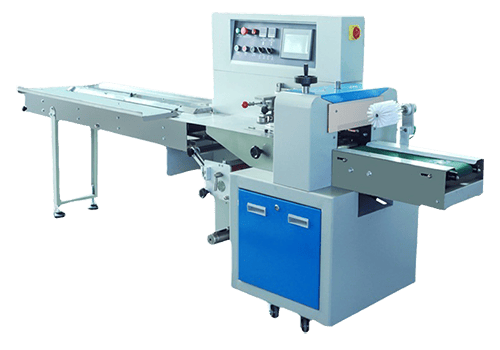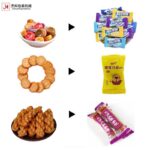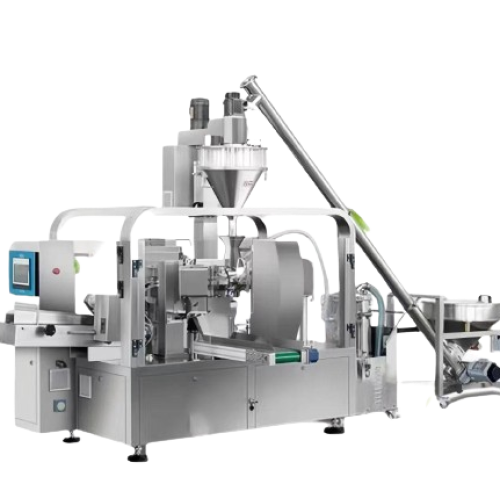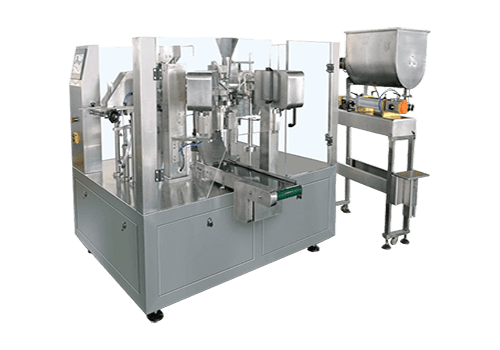

Pastry Packaging Machine
| Column 1 | Column 2 |
|---|---|
| Row 1, Col 1 | Row 1, Col 2 |
| Row 2, Col 1 | Row 2, Col 2 |
| Row 3, Col 1 | Row 3, Col 2 |
| Row 4, Col 1 | Row 4, Col 2 |
| Row 5, Col 1 | Row 5, Col 2 |
MeltVista pastry packaging machine can package finished pastry bags weighing between 100g and 20g at a speed of 10 to 50 bags per minute, making it suitable for large-scale or small-scale pastry food factories.
Compared to traditional manual packaging, the MeltVista automated pastry packaging machine not only improves production efficiency but also reduces the packaging processing costs for factories.
Packaging machine is not limited to pastries; it can also package various solid components such as snacks, pet food, dried fruits, and other similar granular materials.
It is compatible with various pre-made bags, including single-layer PE and PP, multi-layer composite films, and paper bags, ensuring versatility across multiple industries.
MeltVista is designed to optimize your packaging technology while maintaining accuracy and efficiency, whether you are selling food, agricultural products, or industrial parts.
Pastry Packaging Machine Guide
Describe Why We Love Pastries The Commercial Value of Pastries (Packaging)Product Description:
- This pastry packaging machine is a fully automated solution for pastry food processing factories, designed to streamline the packaging process and is ideal for large-scale production. It enhances efficiency, reduces costs, and effectively minimizes material contamination during the packaging process.
Popular Types of Pastries:
- Croissants: Known for their flaky layers and rich buttery taste.
- Danish Pastries: With fruits, cream cheese, or custards as fillings.
- Puff Pastries: Applicable to all manner of dishes, whether savory or sweet.
- Eclairs: A time-honored French classic, purely white with Naugat cream inside and chocolate on top.
- Tarts: A crispy pastry shell combines with fruity or creamy fillings.
Pastries, all over the world, have gained an attractive and impressive appeal through their very release of mastery when perfectly paired with beverages such as coffee or tea.
1. Preservation and Freshness
- Maintaining the quality and freshness of pastries depends heavily on proper packaging. It helps keep the product in top condition from manufacturing to consumption by providing protection against moisture, air, temperature changes, and physical damage. To regulate moisture and avoid staleness, packing methods including airtight containers, modified atmosphere packaging (MAP), and vacuum sealing are often used. These techniques lessen the chance of oxidation and oxygen exposure, which may change the taste and texture of pastries.
- Furthermore, packaging controls temperature, keeping the product's quality from being impacted by either extreme, particularly for pastries that are sensitive to temperature. Certain packing materials, such as foil pouches or insulated wraps, aid in preserving the ideal interior temperature while being transported.
- Additionally, packaging keeps pastries secure from mildew, germs, and dirt from the outside. Hygiene and product integrity are guaranteed by tamper-evident features and food-grade packaging materials. Particularly for delicate pastries, the physical protection provided by stiff containers or cushioned packing also aids in preventing breaking or crushing.
- Effective packaging prolongs the freshness of pastries and lowers waste and spoiling in terms of shelf life. Even in long-distance shipments, items may stay fresher for longer thanks to technologies like vacuum sealing and MAP, which can increase shelf life by weeks or even months. An important aspect of the customer experience is the scent, which is also preserved by proper packaging.
- All things considered, adequate packaging is essential to maintaining pastries' freshness, attractiveness, and safety for ingestion. It is an essential part of the pastry business since it lowers waste, improves product attractiveness, and helps maintain uniform quality.
2. Brand Identity and Marketing
- Packaging is significantly influencing marketing and brand identification in the bakery business. In addition to protecting the goods, packaging plays a crucial role in establishing a positive brand image and attracting consumers. Effective packaging enhances client interactions, conveys the brand's narrative, and helps make a good first impression. Customers looking for sustainability or quality, for instance, may be drawn to packaging that conveys a premium or artisanal image via its design, colors, and materials. Additionally, packaging is a useful marketing strategy that helps companies establish customer confidence by enabling them to prominently display crucial information like as components, nutritional data, and expiry dates.
- Additionally, for contemporary customers who prioritize product lifetime and simplicity of use, convenient functional packaging—like single-serve portions or resealable bags—is essential. By attracting the customer's attention with distinctive or eye-catching designs, packaging might even affect purchasing behavior, particularly for impulsive purchases. Seasonal shifts or limited-edition packaging may also build a feeling of urgency, which encourages purchasing.
- In addition to helping a brand stand out from rivals, attractive packaging also improves consumer happiness and promotes recurring business. Given how important packaging is to consumers' decision-making, bakery companies must make investments in well-considered, enticing, and useful packaging solutions that support their marketing plans and foster long-term success.
3. Convenience and Portability
- Convenience and portability are crucial for pastry packing in the fast-paced world of today. Packaging is essential to satisfying the demands of customers who are increasingly looking for solutions that they can use while on the move. Individually wrapped pastries or tiny, portion-controlled packets are examples of single-serve packaging that provides consumers with a fast and easy snack without the inconvenience of big, heavy packaging. Customers may enjoy their sweets over time without compromising quality thanks to resealable packaging and airtight sealing, which also guarantee pastries remain fresh for longer.
- Additionally, elements that make it simpler for consumers to get their pastries without difficulty, such as tear strips and perforated apertures, improve the user experience. Furthermore, sustainability is becoming more and more significant. Packaging that is recyclable, biodegradable, or eco-friendly not only addresses environmental issues but also offers convenience by being lightweight, cutting waste, and saving money on transportation.
- Cutting-edge packaging options that appeal to customers who are health-conscious, including stackable designs or portion-controlled packs, meet the increased need for functionality and portion control. In the end, packaging that prioritizes mobility and convenience improves consumer satisfaction and fosters brand loyalty. By making investments in sustainable, user-friendly, and convenient packaging, pastry businesses may better compete in the market and satisfy the demands of today's eco-aware, busy customers.
4. Sustainability and Eco-friendliness
- As customers place a higher priority on environmental issues, sustainability and eco-friendliness are becoming crucial considerations in the pastry packaging sector. Companies are switching from conventional plastic packaging to recyclable, compostable, and biodegradable alternatives. Paper, cardboard, and plant-based plastics are becoming more and more popular as alternatives because they provide packaging options that decompose naturally, reducing waste and fostering a circular economy. In an effort to reduce their negative effects on the environment, minimalist package designs are likewise becoming more popular.
- Reducing plastic waste is another aspect of the sustainability movement. Numerous businesses are launching recyclable or paper-based substitutes, and some even provide individual pastries without plastic. Future waste-free solutions have a promising path thanks to innovations like edible packaging made from rice, seaweed, or sugar films.
- Additionally, eco-friendly materials may be used to extend shelf life, guaranteeing that pastries stay fresh without sacrificing sustainability. Environmentally certified packaging, like FSC or biodegradable labeling, is becoming a sign of ethical companies. Pastry companies who use sustainable packaging techniques gain credibility, increase customer loyalty, and differentiate themselves in the marketplace as environmentally concerned customers seek for greener solutions. Adopting these trends satisfies the changing demands of today's environmentally conscious consumers while also helping to preserve the environment.
5. Extended Shelf Life
- In order to maintain freshness, flavor, and safety over time, pastry packaging must have an extended shelf life. Appropriate packaging techniques shield pastries from staleness, contamination, and spoiling—all of which are frequent issues in the sector. Using barrier protection is one of the main strategies to increase shelf life. By limiting exposure to air, moisture, and oxygen, materials such as modified atmosphere packaging (MAP) and vacuum-sealed bags help to establish the ideal environment within the container. This slows down spoiling and helps maintain color, taste, and texture.
- Particularly for cream-filled or perishable pastries, modified atmosphere packaging (MAP) slows the oxidative process and preserves pastry freshness by raising carbon dioxide and decreasing oxygen levels. Additionally, by eliminating air, vacuum sealing keeps the pastry fresh and moist, avoiding drying out and losing its texture. Furthermore, antimicrobial packaging helps prolong shelf life by inhibiting the development of mold, yeast, and bacteria—especially for pastries with delicate fillings.
- Even during transit, fresh pastries remain fresher longer thanks to temperature-controlled packaging, which maintains the perfect conditions for preserving them. Active packaging solutions may also release antioxidants or absorb moisture to prevent pastries from becoming soggy or stale.
- By using these cutting-edge packaging innovations, customers may enjoy longer-lasting goods and increase brand loyalty while also boosting product freshness and reducing waste. In addition to meeting the rising need for high-quality, safe, and fresh products, pastry businesses may broaden their consumer base and boost profitability.
6. Compliance and Safety
- Safety and compliance are essential in the pastry business to guarantee that goods fulfill health regulations and maintain customer confidence. In order to maintain product quality and comply with legal requirements, packaging is essential.
- First and foremost, pastry packaging has to comply with food safety laws, which guarantee that the materials are non-toxic and guard against contamination. Commonly utilized materials that adhere to safety regulations include paper, metal, and food-grade plastics. Another top concern is hygiene; sealed packing methods, such as vacuum packs and modified atmosphere packaging (MAP), shield pastries from germs, dust, and dirt, lowering the possibility of contamination.
- For compliance, labeling must be precise and unambiguous. To help customers make educated decisions and improve traceability in the event of a product recall, packaging must identify ingredients, nutritional data, allergies, and expiry dates. Because pastries may include gluten, dairy, eggs, or nuts, allergy monitoring is also essential. To avoid cross-contact and guarantee the safety of allergic customers, packaging must prominently display certain allergens.
- By making it clear whether the package has been changed, tamper-evident packaging protects customers from dangerous items and guarantees product security. Safety also depends on packaging that prolongs shelf life while avoiding spoiling. Additionally, it must be made to shield pastries from external elements like humidity and light.
- Lastly, packaging that is environmentally friendly is becoming more and more significant. In order to balance safety and environmental concerns, eco-friendly materials, such as recyclable or biodegradable alternatives, must nonetheless adhere to all food safety regulations. Pastry producers guarantee that their goods are high-quality and safe for customers by following these safety and compliance guidelines.



